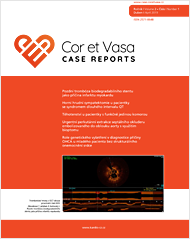 Cor et Vasa Case Reports
Cor et Vasa Case Reports
Svazek | Volume 2 • Číslo | Number 1
Duben | April 2019
 Cor et Vasa Case Reports
Cor et Vasa Case Reports
Svazek | Volume 2 • Číslo | Number 1
Duben | April 2019

J. Naar, A. Krebsová, A. Krüger, D. Vondráková, M. Janotka, J. Šírek, P. Votýpka, M. Macek, P. Neužil, P. Ošťádal
Diagnosing of the cause of out-of-hospital cardiac arrest in young patients ˂ 35 years old is challenging. Some disorders leading to cardiac arrest have monogenic type of heredity – cardiomyopathies, channelopathies. Diagnostic process may be complicated by low penetrance of causal gene mutation and variable expression. Sudden cardiac death or cardiac arrest often appear as the first clinical manifestation or arrhythmogenic cardiomyopathy before the development of obvious structural heart disease. The case re- port presents 27-year-old male athlete who underwent out-of-hospital cardiac arrest with successful cardiopulmonary resuscitation during soccer match. Despite the fact that there were no signs of structural heart impairment according to cardiac imaging and diagnostic criteria for arrhythmogenic right ventricular cardiomyopathy were not fulfilled, genetic testing using next-generation DnA sequencing revealed gene mutation in desmosome protein plakophilin 2, which represents the most frequent molecular background of arrhythmogenic cardiomyopathy. Extension of molecular testing in cardiology may contribute to more precise detection of the causal disease in young surviving patients who experienced cardiac arrest, as well as better risk stratification of their relatives.

J. Tomis, J. Veselka
Percutaneous treatment of secundum type atrial septal defect has become the method of choice in treatment of this congenital heart disease. Embolization of the septal occluder device is recognised as the most common severe complication of the procedure. We report a case of successful urgent percutaneous retrieval of an occluder device using loop catheters and endomyocardial bioptome following embolization to a hazardous anatomical location.

M. Hetmer, T. Zatočil, A. Nečasová, J. Špinar, M. Fiala
Pregnancy is considered as highly risky for patients with complex congenital heart disease after Fontan repair. Complications are expected for mother and fetus as well, regardless of the type of the original disorder. Mothers are threatened by arrhythmias, heart failure and thromboembolism mainly; nevertheless, thrombotic events occur rarely. Though, fetal complications are caused more often due to abnormal and hypoxemic placental circulation, and chronic medication. Significantly more abortions, preterm labors and hypothrophic newborns are observed. In this case report we present a patient with complex congenital heart disease after total cavopulmonary connection (TCPC), who was constantly striving for successful pregnancy despite her health condition. Anti-arrhythmics were purposely discontinued during preconception period; as a result, two attacks of atypical atrial flutter with related heart failure occurred, later treated with radiofrequency ablation. Anticoagulation was reduced due to repeated abortions. Finally, the third pregnancy was successful, although terminated pretermly because of placental abruption. Hypothrophic baby girl was born, but finally has been doing well thanks to medical intensive care.

P. Šandor, L. Blaha, R. Šolek, M. Branny
We are exploring a case of 70-year-old woman with a long QT syndrome, who was indicated to implant an endovasal cardioverter defibrillator (ICD) in VVI mode after a successful cardiopulmonary resuscitation for ventricular tachycardia sorted as Torsade de pointes (VT TdP). After a few years, the ICD had to be explanted due to infection. Therefore she was secured with a subcutaneous cardioverter defibrillator (S-ICD). The S-ICD had to be surgically explanted as well for an infection and a new ICD in VVI mode was implanted. As the patient inclined to rather sinus bradycardia, betablockers were contraindicated. After a few years the patient had repeatedly arrhythmic storms during septic conditions with numerous etiologies. Therefore she was indicated to video-assisted left sympatectomy thoracoscopy. She underwent the procedure without complications. In the next 9-month observation period there were no episodes of ventricular tachycardia. There was no decrease in heart rate and the QT interval remained exactly same before and after the procedure.

T. Nováková, P. Jeřábek, J. Kaňovský
Biodegradable vascular stents (or scaffolds [BVS]) were introduced into clinical use in 2011. These stents represent one of the most advanced technologies, however, the most controversial, too. The scaffolds are made from materials, that degrade over the period of months or years after the implantation. Prevention of cessation of the vessel vasomotoric is usually stressed out as the most positive aspect of the biodegradation. However, the first BVS generation presents with the high risk of the late and very late stent thrombosis (compared to last DES generation). Based on this data, the use of BVS is recommended only in clinical trials in recent ESC guidelines for myocardial revascularization. The case report describes patient, that was admitted to our cardiovascular center due to ST elevation myocardial infarction approximately 12 months after BVS implantation. The case demonstrated several reasons why the concept of BVS failed to prove its benefits, at least in the first generation.